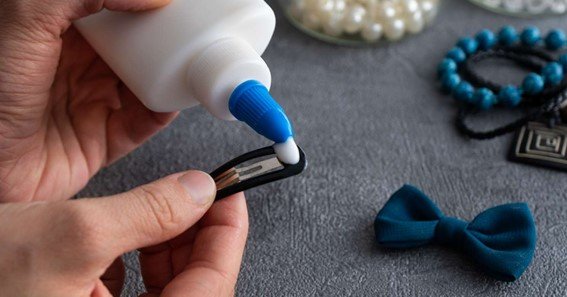What is Glue made of? Glues or adhesives are products used to connect parts collectively. Glue is often a water-based dispersion of polyvinyl acetate. It is used as an opportunity for the animal, primarily Glue, which became used decades ago. Let us know more about what Glue is made of and its preventive measures.
What Is Glue Made Of?
Glue can be made from factors sourced from animals, like collagen synthetic compounds together with polyvinyl acetate or plant starch. There are herbal adhesive dealers, such as natural rubbers, starch, and casein; however, synthetic adhesive marketers are usually used to make Glue. It contains organic substances and can be seen in cave paintings.
The sticks made of glue are hard adhesives in twist or push-up tubes. When you know What is Glue made of why do not we also read about the process of making the same?
Process Of Making Glue

Glue was crafted using natural elements regularly sourced from animals. The procedure typically involves boiling unique elements of animals to extract a sticky substance rich in proteins, known as collagen. This collagen was then processed, refined, and blended with water to create a sticky solution. Upon cooling, the aggregate solidified, offering an adhesive suitable for diverse programs.
As we realize, there are many unique kinds of Glue, and everyone has their own manufacturing procedure. However, here is given step-by-step instructions on how Glue is usually synthetic in the industries –
Preparation Of Raw Materials
Factories gather animal parts from slaughterhouses, tanneries, and meat-packing groups, including remains such as scraps of hide or pores and skin, tendons, bones, feet, ears, tails, fish heads, scales, and skins.
Purification Of The Uncooked Materials
All those elements are washed, dust is eliminated, and everything is soaked so that the elements are softened. Then, all hides and cloth are put through a collection of water baths that have more lime in them. This makes the fabric swell and spoil, and the lime is eliminated using vulnerable acids.
Conversion Into Its Glue Form
Animal cloth is then cooked in boiling water until the collagen protein is released from the shape of the meat and breaks down to its gel form. After several heat treatments at excessive temperatures, the glue fabric accumulates.
Extraction Of Impurities
Cold glue cloth resembles jelly, but it cannot be used simply. Impurities must be extracted. This may be performed both mechanically, such as passing heated glue fluid through mechanical filters, paper filters, or ground bone, and chemically, including alum and acids.
Adding Color To The Glue
Finally, the precise color of the Glue is imprinted by adding components to the mix. Most unusual glue colors are blown, clear, and white, in which zinc oxide produces a white shade, and phosphoric acid, alum, and sulfurous acid are used for different colorings.
At this point, you know what is Glue made of, but can you make the glue at home?
Make Glue At Home

So, to make your Glue at home, we first want to combine equal elements of water and cornstarch in a bowl. Secondly, we need to ease that mixture until and unless it offers a clean texture. Then, we warm the combination till it becomes thick. Please switch off the fuel and let it cool for a while. You also can press lightly from above and then permit it to dry. After it’s cooled then your mixture is ready as Glue and may be used to paste paper, cardboard, etc.
Precautions Necessary While Making Glue

Here are some discreet precautions that need to be considered when you understand What is Glue made of at the time of production glue in a commercial putting:
Personal Protection:
Ensure employees wear suitable gear, such as gloves, safety glasses, and lab coats, to defend themselves from possible dangers like chemical explosions in the lab. Making glue requires many different chemicals, which is hazardous for people working in the industry.
Air Quality:
Using this technique, the glue production must be carried out in a well-ventilated location to remove toxic fumes or dirt. This prevents people from inhaling the poisonous air-launched throughout the process, keeping the air first-rate.
Chemical Care:
It is to be stated that all equipment must be handled with care, as various acids or chemicals may be used, which could damage a human’s pores and skin. Avoid spills, leaks, and direct contact with skin or eyes.
Fire Safety:
There is a high chance of the workspace getting fire, so it’s cautioned to keep a fireplace extinguisher close by in case something like that occurs. To avoid a situation like this, people want to keep the flammable materials far away from the main place.
Staff training:
Provide comprehensive education to all employees on production techniques, proper handling techniques, safety protocols, emergency response, and gadgets and machinery. This is important as appropriate handling of the tools and chemicals will ensure the safety of all the individuals working to make Glue.
Conclusion
You now know What is Glue made of. The composition of Glue varies depending on its type and intended utility. Regardless of the elements used, safety precautions must be observed during glue production to protect employees and ensure product quality. By knowing the substances and manufacturing processes involved, manufacturers can produce first-rate Glue for various applications.
FAQ
Are there green alternatives to traditional Glue?
Green glue is crafted from herbal plant-based substances, including starch, cellulose, or herbal gums.
Can we use plant-based elements to make Glue?
We know Glue needs starch to make Glue. The statues are extracted from plants like corn and potatoes, and after we combine this starch with water and add some additives, it gives out the perfect Glue that we use.
What are a few commonplace applications for Glue?
Glue is used in various programs, including woodworking, production, crafting, packaging, and repairing family objects.
What styles of artificial chemicals are used in Glue?
Synthetic Glue may also comprise chemicals, polyvinyl acetate, cyanoacrylate, and epoxy resins.
Is Glue always derived from animal merchandise?
No, while historically, many glues were derived from animal resources like collagen, present-day glues can also be made from artificial or plant-based materials.
Check out some interesting posts Gary Brecka Book.
Sources:
https://www.adhesivesmag.com/articles/86751-safety-first-safe-handling-of-adhesives-and-sealants
https://www.treehugger.com/what-glue-made-4847390
https://www.cedesa.co.uk/everything-you-need-to-know-about-glue
We have covered all the below topics in the above article
Glue ingredients
Composition of glue
Glue materials
What is glue made from










